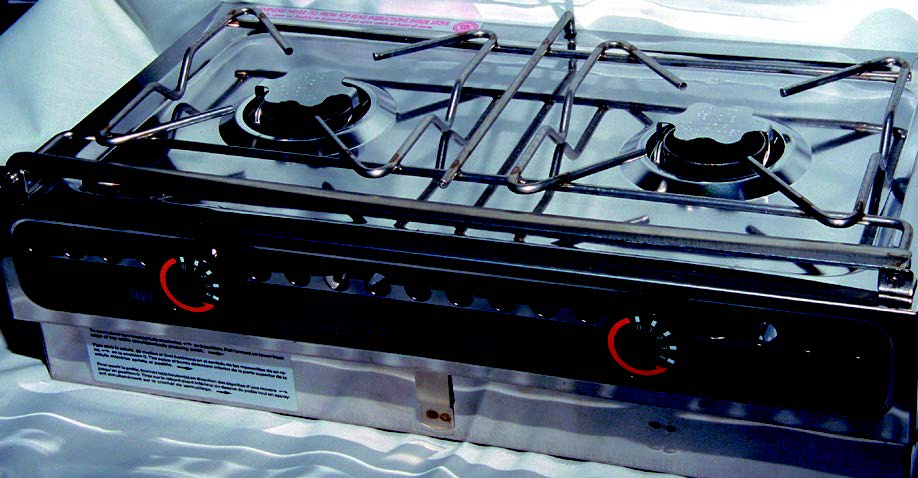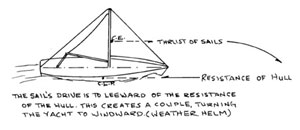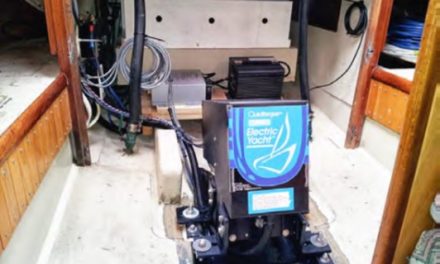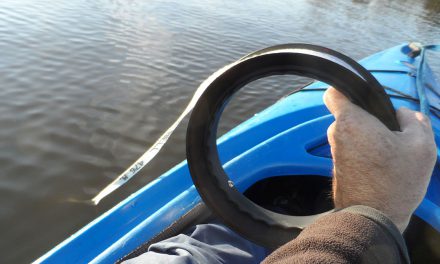A clean look at the “dirty” half dozen
Pros and cons of the six main fuels for galley stoves
When it comes to choosing a marine stove fuel there is rarely anyone completely happy with the choice. All fuels have a “dirty” side to them, and some sides are deadly as well. Alcohol is heating-impaired. Kerosene is maintenance-dependent, and a mess if spills occur. Diesel is hot and has sooting problems. Electricity is power-hungry and generator-dependent. Compressed natural gas (CNG) is explosive and expensive, as well as hard to find. And what about liquefied petroleum gas (LPG)? The potential for a massive explosion aboard your good old boat gives LPG both a deadly and a “dirty” side.
After talking to more than 30 marine stove owners about their fuel and stove choices, I learned that, like me, almost every one of them had learned to cook and live with whatever stove and fuel came with the boat when they bought it. But, even though it was chance that decided it, most owners were happy with their stoves and fuels.
As the years go by, however, good old boats need refitting. We may need to replace our stoves. Then when it comes to fuels, choosing one of the dirty half dozen is unavoidable, and this time it won’t be chance that decides. We are wrestling with this decision aboard Lindsay Christine, our Mercator Offshore 30. Our propane stove is more than 20 years old. And it looks it, at least what you can see of it, because most of it has rusted away. In the hopes of making the “right” decision, I did extensive research and asked many boaters about the marine stoves and fuels they use.
What follows are some pros and cons of marine stove fuels from my own research and some advice from the experts – other stove owners – to help you decide which is the best choice for you.
Heat vs. cost
|
Average Heat Content of Marine Stove Fuels
|
||||
|
Fuel Type
|
Btu/lb.
|
Btu/ significant unit
|
Cost
|
Cost/ 5,000 Btu
|
| Alcohol |
11,935
|
80,919 Btu/gal.
|
$9/gal.
|
$55.61
|
| CNG |
23,601
|
1,000 Btu/ft.
|
$.16/ft.
|
$77.38
|
| Diesel |
19,557
|
139,400 Btu/gal.
|
$1.30/gal.
|
$4.66
|
| Kerosene |
19,800
|
134,950 Btu/gal.
|
$2.07/gal.
|
$7.67
|
| LPG |
21,560
|
21,560 Btu/lb.
|
$.50/lb.
|
$11.60
|
| Electricity |
–
|
3,412 Btu/kwh
|
$ .10/kwh
|
$14.65
|
The heat output of fuels is determined by test. The table on the next page shows approximate heating values – approximate because, with the exception of electricity, all of these fuels are mixtures, and their exact content varies from source to source.
One Btu, or British thermal unit, is the amount of heat energy needed to raise the temperature of 1 pound of water 1°F, starting at 60°F. One Btu is also equivalent to 252 calories, and 1 calorie is the amount of energy needed to raise the temperature of 1 gram of water 1°C.
The Btu/lb. column in the table offers a way to compare all fuels (except electricity) with each other. Btu/lb. would only be a significant figure of merit, however, in cases where the major consideration was the weight of the fuel load. If you are doing a serious weight comparison, you will want to include the weight of all parts of the cooking system, including the tanks, plumbing, and stove.
Most sailors will care more about the cost and availability than about the weight difference. The column showing Btu per significant unit is provided to show the heat content of the unit of measure in which the fuel is normally purchased.
The cost per 500,000 Btu shows how significant the difference is between various fuel costs. For purposes of comparison, 500,000 Btu may be taken to be (very roughly) the heat required to cook for four people for 90 days. If you live aboard your boat, multiply that figure by four for an estimate of annual cost. If you sail in a northern climate on weekends and get in a two-week vacation, your annual fuel requirement will likely be only about half of the 500,000 Btu shown.
Generally speaking, the cost difference between these fuels for weekend sailors is not significant enough to be the reason for changing fuel types, because the cost of new equipment is high relative to the cost differences between fuels. Liveaboards and long-ra nge cruisers may find the cost differences more interesting.
Fuel availability
|
Availability of Fuels
|
||
|
Inside the U.S.
|
Outside the U.S.
|
|
|
Alcohol
|
Yes
|
Random
|
|
CNG
|
Random-Rare
|
Rare
|
|
Diesel
|
Yes
|
Yes
|
|
Kerosene
|
Yes
|
Yes
|
|
LPG
|
Yes
|
Yes
|
Here is a table showing the availability of fuels – excluding electricity, since electricity is generated by using another fuel. I used the word random to describe the availability of CNG in the U.S. because, even with a long list of available stations, I had great difficulty finding a place that really did refill CNG cylinders in Florida, where I live. But I’ve been told it’s much easier to find in other parts of the country where EPA standards have forced the use of CNG as a motor fuel and where natural gas is a common fuel for heating.
Auto-ignition temperature
The table on the next page shows the characteristics of fuels, also excluding electricity. It gives the auto-ignition temperature of each fuel. This is the temperature at which a fuel will automatically ignite without a spark or flame. The flash point, on the other hand, is the temperature at which the fuel will ignite when there is oxygen and a spark for ignition.
Stove fuels one by one
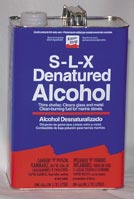
Alcohol
Alcohol fuels for stoves are generally composed of ethanol, methanol (added as a denaturing agent), methyl ethyl ketone, acetone, and water. The exact percentage of these components varies rather widely from one supplier to another. Nigel Calder, in his book, Boat Owner’s Mechanical and Electrical Manual, states that the best fuel for stoves is ethanol. For practical purposes, this would be a fuel like Tru Heat, which is 92 percent ethanol, 5 percent water, and 3 percent methanol. It has only trace amounts of other compounds, such as methyl isobutyl ketone, ethyl acetate, and rubber cement. In contrast to this fuel, Soot-Free, the fuel endorsed by Origo for use in their stoves, is not a high-ethanol-content fuel. Soot-Free contains roughly 71 percent ethanol and 20 percent methanol, as well as methyl ethyl ketone, acetone, and water.
You can also buy suitable fuel in paint and hardware stores labeled as “denatured alcohol.” Kleen Strip is one brand that notes on the container that it is suitable as a shellac thinner and as marine stove fuel.
One test Nigel suggests is to pour a sample of the fuel into a clean (oven-proof) dish and burn it. If there is any residue after the fuel is completely burned, it’s unsuited for use as a stove fuel. In addition, stove-fuel vendors will send you a Material Safety Data Sheet (MSDS) for their products listing the chemicals in the fuel by percentage.
Alcohol has been advertised to be the perfect environmentally correct fuel because it is mostly produced from renewable resources (plant matter). It is a relatively safe fuel because of its low volatility. This makes it safer than other fuels in the closed environment of a boat. Alcohol-stove owners like the fact that there is no hauling of heavy and cumbersome storage tanks, that fires can be extinguished just by adding water to the fire or fuel, and that it is a clean-burning fuel.
But it’s not the perfect fuel. Some people say the sweet smell of burning alcohol makes them nauseous. It’s more expensive per Btu than all the other alternatives except CNG, averaging $9 a gallon across the U.S., and its availability is irregular outside of the U.S. and Canada. The price of alcohol outside the U.S. is also quite high.
There are two basic types of marine stoves that use alcohol as a fuel, pressurized stoves and non-pressurized stoves. Each has advantages and disadvantages.
Pressurized alcohol
I chuckled as I read LaDonna Bubak’s description of lighting her pressurized alcohol stove. She sails her boat out of Portland, Ore., and writes:
“(First you) have to fill a small tank, pump it up to pressurize it . . . preheat the burner by allowing a puddle of fuel to develop, light it, jump back so flames don’t singe eyebrows, extinguish (any) flaming curtains, etc., then, when the puddle-flame almost dies, you turn on the burner and hope it catches.” A lost memory flashed into my mind. It was my first and only attempt to light the pressurized alcohol stove aboard our Catalina 22. As flames shot up above my head and within reach of the cabintop, I heard the kids approaching. They were arguing about whose idea it was to have lunch aboard Gypsy Rose. Trembling, I made sure the burner was off, then nervously searched for something with which I could extinguish the flame. There was no water. Gypsy Rose was in our driveway. I found a pot lid that had fallen on the cabin sole in the confusion of the flare-up. The fire went out as I covered it. I took a deep breath. Amie arrived first with Alex close behind, full of spit and vinegar.
“Mommy, tell Amie that I thought of it first! Here’s the soup . . . ” Then there was silence as they both watched me pack up everything and start to close up the boat. “Mommy, are you OK?” I vowed never to light that stove again as I replaced the tarp and walked back to the house. I had no idea that this experience was almost normal for lighting a pressurized alcohol stove until I talked to other boaters about their stoves.
A few of the boat owners I questioned were happy with their pressurized alcohol stoves, but the majority were looking to replace them. Many were not comfortable using the oven because of concerns with priming and flare-ups. A few owners commented on being bothered by the sickeningly sweet smell of the alcohol and the paleness of the flame, which makes it almost impossible to see in bright light.
The real danger of flare-ups seems to come from failing to light the burner on the first try. After the first try, the burner may not be hot enough to sufficiently vaporize the fuel by the time all the fuel in the priming cup has been burned. So the chef opens the control knob to allow more fuel into the priming cup, and the fuel ignites sending flames sky high. While the burner was not hot enough to vaporize the fuel the first time, it was hot enough to ignite the liquid alcohol added again. If the stove is gimbaled at the time of lighting, flames can splash onto other parts of the boat and the cook. According to Optimus International, the best advice is to let the burner cool off before filling the priming cup with fuel again.
Pressurized alcohol stoves are not maintenance-free. The customer service department of Kenyon Stoves explains that severe pulsing of a burner or a glowing red cap during operation are caused by dirt and scale buildup in the filter and burner body. The burner should be stripped of all removable parts, cleaned, and rebuilt.
With Kenyon alcohol stoves, a wick in the center of the burner is lit. Pressure builds up in the burner as the available fuel heats up, causing alcohol vapors to be released into the burner to be used. Regardless, most alcohol burners work in the same way and require the same maintenance.
One stove owner, known as “Captain Key West,” from Key West, Florida, commented that he thought the bad press about pressurized alcohol stoves comes from the fact that they need to be maintained to work well, especially after many years of use. He writes, “I think many people disenchanted with alcohol stoves may have based their opinions on only having used poorly maintained stoves. I used to be surprised how alcohol stoves got a bad “rap” since mine worked great for many years before it started getting “fussy.” Now, I realize many users are not aware that these stoves are not maintenance-free. They buy a used boat, never can get the stove to work right, then complain about how poor alcohol stoves are. They’re not listening to their stoves which are begging for maintenance!”
I know I never gave my pressurized alcohol stove a chance after that first lighting.
Non-pressurized alcohol
| Characteristics of the five liquid or gaseous marine stove fuels | ||||||
|
Alcohol
|
CNG
|
Diesel
|
LPG (Propane)
|
Kerosene
|
||
|
Methanol
|
Ethanol
|
|||||
| Toxic to skin |
Moderate-high
|
Slight
|
No
|
Moderate
|
No
|
Moderate
|
| Toxic to lungs |
Moderate
|
Slight
|
No
|
Moderate
|
No
|
Moderate
|
| Specific gravity |
1.11
|
1.59
|
0.55 lighter than air
|
>4
|
1.52
|
>4
|
| Auto-ignition temp |
867
|
793
|
1,000
|
-600
|
850-950
|
410
|
| Flash Point |
52
|
55
|
-300
|
165
|
-100to -150
|
100
|
| Luminous flame |
No
|
Faint
|
Yes
|
Yes
|
Yes
|
Yes
|
| Source |
Natural gas & other hydrocarbons
|
Grain, biomass
|
Natural Gas
|
Petroleum
|
Natural gas, petroleum
|
Petroleum, coal, shale
|
Non-pressurized alcohol stoves are quite popular. The Origo brand stoves have helped to keep alcohol in fuel-option lists for boaters. All non-pressurized alcohol stove owners I questioned are happy with their stoves. Some even commented that they cook faster than pressurized alcohol stoves and claimed speed close to propane. But the fuel is expensive.
These non-pressurized stoves use a wicking action to deliver fuel to the flame, instead of pressure, making them very safe, with no flare-ups. The fuel is stored in canisters under the cooktop. The canisters contain nonflammable wadding with a shield-type cover that closes over the canister to extinguish the flame, somewhat like cooking with Sterno.
These stove users/experts seem to agree that non-pressurized alcohol stoves are the way to go if you are interested in using alcohol as a marine stove fuel. In fact, two of the pressurized kerosene stove owners are switching to non-pressurized alcohol with their next refit.
Safety considerations (alcohol)
While it is true that alcohol fires can be put out with water, sometimes the water displaces the alcohol, and the fire continues to burn.
- Fill the fuel tank no more than three-quarters full to allow space for increased air pressure.
- Before lighting and throughout the burner’s use, pressure in the storage tank needs to be around 7 pounds per square inch (psi).
- Once you have successfully lit the burner, run it on a low setting until the burner gets really hot; then it can be adjusted for your cooking. Turning the valve all the way open will put out the flame, because there is a cleaning needle that comes out when you turn the knob all the way counterclockwise.
- Never refill the priming cup or stove while the burner is on or even hot. The alcohol in the container may ignite.
- Clear the area above and around your stove of any flammable objects, including your eyebrows, before priming your stove.
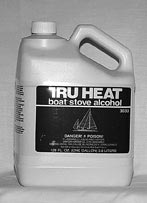
Special hints (alcohol)
- Experienced users of alcohol stoves recommend that you use heavy cookware to reduce the scorching that can occur if the burner has a hot spot.
- On pressurized stoves, cook and bake using a strong flame to reduce chances of the flame’s dwindling and being blown out.
- Most owners agree that it helps to use the stove manufacturer’s fuel because it burns more cleanly.
- One owner uses a contact-solution bottle to hold alcohol for the priming process. It give you better aim and more control over the amount released.
- Pressurized alcohol stoves can be converted to kerosene by replacing the burners. As a caution though, one stove owner commented that he was witness to one such conversion exploding aboard a friend’s boat. Make sure the conversion is done correctly.
- Several owners use small bicycle pumps with pressure gauges to pressurize the fuel tank to the proper pressure. Ferenc Maté’s book, Shipshape: The Art of Sailboat Maintenance, explains the use of a bicycle pump for pressurized alcohol and pressurized kerosene stoves. He suggests getting rid of the pump that came with the stove and finding a valve from a bicycle tube. Solder this valve into a washer and use the nut that came with the tank to thread it into place with a small rubber gasket between.
- Dan Spurr, in his book, Upgrading the Cruising Sailboat, recommends putting a pot on the burner when priming. It will partially contain the flames and provide a darkened area which enables you to see the flames better.
Compressed Natural Gas
There’s a lot of technical merit to compressed natural gas, but its popularity has never developed. Natural gas is a mixture of hydrocarbons – mainly methane (CH4) – and is produced from gas wells or in conjunction with crude-oil production. It’s a very clean-burning fuel and burns hotter than alcohol. It also has an advantage over LPG in that it is lighter than air. So it is a much safer gas. Any leaks tend to rise to the cabintop and escape through any point that has an opening to the outside. But vapors could still build up in areas of the cabin that have poor ventilation, so care should be taken to have good airflow aboard. I know of one boatowner who has had trouble-free use of his CNG stove for the last 16 years.
CNG’s disadvantages are much the same as LPG’s. It’s a highly volatile gas stored under pressure, much higher than LPG. CNG is stored at 2,250 psi, compared to LPG’s 150 to 180 psi. The cylinders are heavier and more cumbersome because CNG requires a thicker-walled tank. The tanks also require recertification periodically. CNG also costs more per Btu than LPG. I found the price of a refill in Florida to be between $10 and $16 for 84 cubic feet.
But the biggest drawback seems to be the lack of availability outside the U.S., as well as in some areas within the U.S. A special quick-release fitting can be bought through Corp Brothers, Inc., to allow you to fill your tanks from a utility-company or automobile-station pump, when found.
Safety considerations (CNG)
A good-quality, spark-proofed alarm and sniffer should be installed aboard any boat with a compressed natural gas stove.
- CNG cylinders should be stored away from the cabin in self-contained storage lockers that are vented overboard above the waterline, with venting at the compartment’s highest level. Or they may be stored outside on deck.
- Cylinders should never be painted a dark color. In direct sunlight a cylinder could absorb enough heat to cause it to rupture.
- CNG and LPG cannot be interchanged without modification to the stove.
- CNG burned in LPG stoves will produce only about half of the designed output.

Diesel
Diesel is a high-energy fuel that is not volatile. It does not give off flammable fumes, and it is inexpensive and available worldwide, especially in areas of commercial fishing. There are pressurized and non-pressurized diesel stoves. Pressurized diesel stoves are operated much like kerosene and alcohol stoves. Non-pressurized “drip pot” diesel stoves use a metering valve to deliver fuel to a drip-pot-style combustion chamber. The burner can be fed by gravity or by a pump. The drip-pot-type stoves are quite popular on commercial fishing boats and aboard yachts in northern regions.
They are known for producing a dry heat because they draw in moist air from the cabin for combustion and expel it through the chimney as flue gas. For boaters living in cool climates most of the year, this means a warmer and drier boat. Drip-pot diesel stoves can also be used to produce hot water when a water coil is added to the stove. Another advantage is the fact that you will only be using one type of fuel if your auxiliary engine is diesel.
A downside for drip-pot diesel stoves is that they tend to heat the cabin as well as the food. They are slow to warm up and cool down because they are made of heavy cast iron. With a constant oven temperature of 350°F, a cabin can get quite warm in the tropics. Sooting and down drafting can also be problems when a drip-pot diesel stove is not properly adjusted or if poor-quality fuel is burned. Installation of the drip-pot variety can be quite difficult just because of the weight of the stove itself. And, because of their weight and the chimney required, drip-pot diesel stoves cannot be gimbaled. It would be best to install one athwartship. Since the flue removes combustion products from the cabin, the build-up of carbon monoxide gases is not a concern as long as the stove is working properly and outside make-up air is brought into the cabin.
Special tips (diesel)
The key to being happy with your diesel stove is to learn how to operate and adjust it. Understanding how your stove works, and adjusting it properly, will save your sails (as well as the rest of your boat) from soot. Jeannie and Jack, aboard their Columbia 50, Terri Knot, had terrible sooting problems with their diesel stove on their trip to Alaska. After several phone calls to the manufacturer, they were finally able to adjust it properly. They are pleased with the heat it generated while cruising in the cool north. But Jeannie commented that it would have made the trip more enjoyable if they could have worked out the stove’s idiosyncrasies before their trip.
- Filtering your diesel fuel with a “Baja” filter will increase the efficiency of your stove and reduce sooting. If you don’t have a very fine filter of this type, you can also filter fuel to some extent using panty hose.
- If you are planning on cruising in tropical climates with a diesel stove, consider bringing along a small cook-top that uses an alternate fuel – such as propane, butane, or alcohol – to reduce heat in the cabin.
- Diesel stoves will burn cleanly with sufficient draft. Make sure your flue is the proper length and diameter. It is important that the flue be installed without any bends to restrict the air flow. Make-up air must be allowed into the cabin for the stove to have proper draft.
Electricity
For those boaters who have an alternating current (A/C) generator, or who find themselves close to shorepower quite often, electricity may be the answer. It is highly efficient, there are no problems about storage and fumes, and the fact that you may already have shorepower aboard your boat makes it easy to install. If your electrical cooking appliances include a microwave, it will speed up cooking times, helping you to use less energy. It will also conserve vitamins during cooking, and it will not heat up the cabin. Because electricity is a dry heat, it will also mean a drier cabin, something that helps with all boats.
But, if you will be relying on a generator to power your stove, there will be an increased need for diesel or gas, depending on your energy source. Increased use of your generator also means increased wear and maintenance, increasing the total expense of this type of fuel. The noise of having to run the generator or engine each time you use your electric appliance can also be a disadvantage.
Special tips (electricity)
- Make sure all wiring is accessible so you can check for corrosion periodically. If some of the wires are hidden or difficult to get to, it will be a tedious job to find the cause of a malfunction.
- Proper maintenance of your generator is a necessity when relying on electricity for your cooking. Consider having a small back-up stove aboard.
- If you will be running your generator in quiet anchorages, consider anchoring farther away from other boaters. It will go a long way toward improving relationships with those who are living without generators.
- Try to combine stove needs with battery charging to enable you to run the generator less frequently.
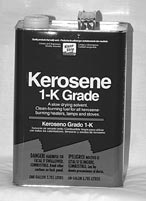
Kerosene
Kerosene, also called paraffin outside the United States, is a colorless, thin oil. It’s less dense than water, and it’s made of a mixture of hydrocarbons commonly obtained from the fractional distillation of petroleum. As with alcohol, there are pressurized kerosene stoves and non-pressurized kerosene stoves. Pressurized ones function much like pressurized alcohol stoves. Kerosene burns hot – much hotter than alcohol. It is inexpensive and widely available in the U.S. as well as overseas.
Eric Freeman, who sails Blackguard, an old Seawolf ketch, in northern Washington state, commented that kerosene is easy to find, being available anywhere jets fly. Kerosene is not as volatile as alcohol and can be easily stored. Because kerosene – like alcohol and diesel – doesn’t have to be under pressure, it is easy to be aware of how much fuel you have left. A well-maintained and properly running stove is odorless and soot-free without any flammable fumes to worry about.
But kerosene stoves can be hard to light. These stoves require priming with alcohol, a tricky business. They can also have a sooting problem if the burners are not adjusted properly. They can smoke liberally when firing up and smell terrible. Spills take a long time to evaporate and can be a problem because they will soak into cushions and be a fire hazard for a long time.
Non-pressurized kerosene stoves are often discussed with diesel drip-pot stoves since they are so similar. Kerosene can be burned in a diesel stove and is the cleaner of the two in that application. The advantages and disadvantages of non-pressurized kerosene stoves are the same as those for diesel stoves. Like diesel stoves, kerosene drip-pot stoves cannot be gimbaled and are usually made of heavy cast iron with a flue.
Special tips (kerosene)
- It’s important to buy the best-quality kerosene possible to reduce the chances of clogged burners. Good-quality kerosene is colorless and as clear as good drinking water.
- You can check the quality by burning a small puddle in an ovenproof dish. Any gooey remainders mean a poor-quality fuel for your stove.
- Filter your kerosene through a “Baja” filter to eliminate particulates.
- Keep a small spray or squirt bottle of alcohol (like a contact solution bottle) close by to use when priming the burner.
Liquefied Petroleum Gas
LPG is a gaseous paraffin hydrocarbon, extracted from crude petroleum or natural gas, containing propane and butane. Most LPG produced and sold in the U.S. is primarily propane. It seems to be the fuel choice for a large number of marine-stove owners, especially international cruisers. They seem drawn to it because it is cheap, burns hot and clean, and has world-wide availability. I found the average price to fill a 20-pound cylinder was $10, which lasts our family of four an average of three months while traveling. But, it has some major drawbacks that can make it a very dangerous fuel to have aboard.
LPG is highly explosive and heavier than air. Any leaks in the system can go undetected, sinking into bilges and creating a very dangerous situation. And, on stoves without thermocouples, it is too easy to leave a burner on accidentally after the flame goes out, leaving an explosion waiting to happen when the cook goes to re-light a burner.
Thermocouple-controlled solenoid valves control the flow of gas on some stoves. When heated, the dissimilar metals in the thermocouple generate electrical current that causes the solenoid valve to open. When the thermocouple cools, it does not generate the electrical current and thus the valve closes, cutting the supply to the burner. This is why, upon lighting your burner, you need to hold the valve open for at least 30 seconds to allow the metals to become warm enough to generate the electrical current which will hold the solenoid valve open.
LPG (as well as CNG) requires constant vigilance in its use and storage on board. All crewmembers should check and re-check to make sure all switches and shut-off valves are in the proper position. LPG’s high volatility also creates a transportation problem. Transporting cylinders to be re-filled can be difficult. The thick-walled cylinders are heavy and cumbersome. These cylinders, like CNG cylinders, have to be re-certified after several years. The date of the next re-certification should be stamped on the cylinder. Due to safety concerns, many buses and taxis will not allow usually outside of town in order to reduce loss of life and property should there be an explosion. This makes them difficult for cruisers to reach without transport.
Though propane and butane are usually lumped together and called LPG for simplicity, they have a few differences.
Butane: This gas liquefies at higher temperatures than propane does. At extremely low temperatures, butane’s evaporation rate will be so low that the stove will not operate. But butane can be stored in a propane container.
Propane: In extremely cold conditions, propane can be used when butane would fail to evaporate. Propane can be used interchangeably with butane. But propane cannot be stored in butane cylinders because it has a higher cylinder pressure.
Safety considerations (LPG)
|
Marine Stove Fuel Survey Results
|
||||
| Fuel | Happy | Safe | Feel limited in use | High fuel price |
| Alcohol (pressurized) |
Yes: 1 No: 3
|
Yes: 1 No: 3
|
Yes: 2 No: 2
|
Yes: 3 No: 1
|
| Alcohol (non-pressurized) |
Yes: 6 No: 0
|
Yes: 6 No: 0
|
Yes: 1 No: 5
|
Yes: 3 No: 3
|
| CNG |
Yes: 1 No: 0
|
Yes: 1 No: 0
|
Yes: 0 No: 1
|
Yes: 1 No: 0
|
| Diesel |
Yes: 1 No: 0
|
Yes: 1 No: 0
|
Yes: 0 No: 1
|
Yes: 1 No: 0
|
| Electricity |
Yes: 2 No: 0
|
Yes: 2 No: 0
|
Yes: 0 No: 2
|
Yes: 2 No: 0
|
| LPG |
Yes: 15 No: 0
|
Yes: 1 No: 14
|
Yes: 0 No: 15
|
Yes: 15 No: 0
|
| Kerosene (pressurized only) |
Yes: 2 No: 1
|
Yes: 3 No: 0
|
Yes: 0 No: 3
|
Yes: 3 No: 0
|
For excellent instructions on the proper installation of an LPG system, read Chapter 14 of Nigel Calder’s Boatowner’s Mechanical and Electrical Manual.
- It is a good idea to install a good quality sniffer that will sound an alarm when vapors are detected. But be sure it is spark-proofed so that turning it on will not ignite any vapors already present.
- LPG cylinders should be stored away from the cabin in self-contained storage lockers that are vented overboard above the waterline, with venting at the compartment’s lowest level. Or, they may be stored outside on deck.
- Cylinders should never be painted a dark color. In direct sunlight, a cylinder could absorb enough heat to cause it to rupture.
- Install a lighted manual switch at the stove with a solenoid valve to shut off the gas at the tank when the stove isn’t in use.
- LPG cannot be interchanged with CNG (compressed natural gas) without modifications to the stove. Propaneburned in a CNG stove will produce extremely high flames and dangerous overheating of the appliance.
- When re-filling cylinders outside the U.S., make sure the LPG has a smell to it. It is not safe to have LPG (or CNG) aboard if it is odorless.
- Be careful not to have your cylinders filled beyond 80 percent capacity. There should be two weights stamped into your cylinder, the empty weight, called tare weight, and its net fill weight, the safe weight of LPG that can be added. Upon weighing your filled tank, it should not weigh more than your tare weight plus your net fill weight. If it has been overfilled, some of the gas will need to be vented carefully away from flames and sparks. An overfilled cylinder is a terrible danger aboard your boat. Increases in the ambient temperature could cause a rupture of the cylinder or could cause liquid LPG to be pushed into the low-pressure lines, a very dangerous situation that would ruin, at the least, an oven’s thermostat.
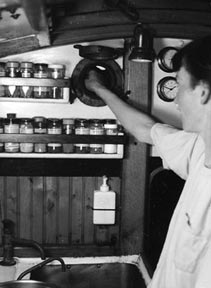
Debbie Lyons, reaches through the portlight to shut the propane off at the tank aboard Rhiannon.
Special tips (LPG)
Having an easy shutoff valve close to the storage cylinder helps reduce dangers. Aboard Rhiannon, Debbie Lyons, of Seattle, stores her propane cylinder on deck near an opening portlight over her sink. She only has to open the portlight to shut off the propane right at the tank. She shuts off the propane at the cylinder as her cooking is completed and when the flame dies, signaling that all the propane has been used in the lines, she turns off the burner. Before lighting, as a double check, she makes sure that all burners are turned off first. (Make sure the portlight will not allow LPG to drain into the cabin if there is a leak at the cylinder.)
Hunting for leaks is required maintenance for propane stove owners. It is a good idea to periodically apply soapy water to all tubing connections in your installation. Bubbling signals a leak that should be immediately fixed. Also use your nose for finding leaks. As with CNG, an odor has been added to LPG. Never use a flame to test for leaks.
To check the level of your propane tank, boil a cup or so of water and pour it on the outside of your propane tank. Right afterward, feel for the level of much cooler propane in the cylinder.
Propane and CNG are serious materials to have aboard a boat. The ABYC (a voluntary boat construction standards organization) recommends that the following label be placed near LPG fuel tanks:
Caution
- This system is designed for use with liquefied petroleum gas (LPG) only. Do not connect compressed natural gas (CNG) to this system.
- Keep cylinder valves and solenoid valves closed when boat is unattended. Close them immediately in any emergency. When on board, cylinder valves or solenoid valves shall be closed when appliances are not in use. Keep empty cylinder valves tightly closed.
- Close appliance valves before opening cylinder valves.
- Test for system leakage each time the cylinder supply valve is opened for appliance use. Close all appliance valves. Open, then close, cylinder supply valve. Observe pressure gauge at the regulating valve and see that it remains constant for not less than three minutes before any appliance is used. If any leakage is evidenced by a pressure drop, check system with a leak detection fluid or detergent solution which does not contain ammonia and repair before operating the system.
- Never use flame to check for leaks.
At the end of the ABYC standard on LPG systems is the following note:
- Never use flame to check for leaks!
- Never use solutions containing ammonia. Ammonia, which is present in soaps and detergent, attacks brass fittings. Undetectable at first, in a matter months these fittings may develop cracks and leaks.
Ammonia which is present in some soaps also attacks copper tubing in the same way. In fact, it is the copper in the brass that is attacked by the ammonia.
Watch out for CO
With electricity as the exception, it’s important to make sure that the galley has sufficient oxygen to keep the stove working properly. A deficiency of oxygen causes any fuel to burn improperly, resulting in an output of carbon monoxide, rather than carbon dioxide.
For this reason, a carbon-monoxide detector is a worthwhile investment. We have one aboard our boat that saved our lives in Alaska. One night after having hot cocoa before bed, we accidentally left the pilot light in our oven on. Even with a cracked hatch, there was not enough oxygen inside the cabin. We were slowly awakened when our CO detector went off, releasing a mind-boggling blare of noise that just barely woke my husband, Chuck, and me. The kids were sound asleep with the detector right above their heads. We were able to get the kids and ourselves out of our cabin in time, with only headaches to complain about. The fresh air never felt better. Now we make sure the CO detector always has a good battery.
Decisions, decisions
In Jimmy Cornell’s book, World Cruising Survey, the most popular cooking fuel was LPG. In fact, 138 boaters chose LPG with the other fuels barely showing up: 17 others chose kerosene; two chose diesel; one chose alcohol; and two chose electricity. LPG was the most popular choice among the people I talked to, as well. But I found many more owners who chose alcohol than Jimmy did. This is probably because I talked to coastal cruisers and weekend boaters. I also talked to only 32 stove owners. For what it’s worth, refer to the chart of my findings on Page 53.
Which to choose?
After weighing all of the pros and cons of the dirty half-dozen, I still haven’t made up my mind about which to choose. But our plans for cruising outside the U.S. have ruled out CNG and alcohol. And electricity won’t work aboard our boat without a generator. LPG is at the top of our list, but I hesitate because of memories of singed arms, flames in my face lighting our oven, and waking up to our carbon monoxide detector blaring. All these are memories from forgotten pilot lights and burners not turned off completely. It makes me gun-shy. I know the safety mechanisms on the new LPG stoves, as well as a proper installation, will take care of those problems. But should I choose to have our family depend on that?
Then there’s kerosene and diesel to consider. Decisions, decisions. Maybe we could buy a new good old boat with a stove already installed so I could leave this decision to chance. Maybe I’ll make Chuck decide.
Article from Good Old Boat magazine, March/April 2000. This and other cooking aboard articles are also available in the Good Old Boat Galley Book.

